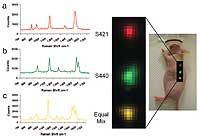Apr 21 2008
Using nanoparticles designed specifically to produce a bright Raman spectroscopic signal, a team of investigators at the Center for Cancer Nanotechnology Excellence Focused on Therapy Response (Stanford CCNE) has shown that it can produce whole-body images in small animals that can reveal the location of tumors and track how these nanoparticles traffic through the body. This work, the first to use surface-enhanced Raman spectroscopy (SERS) to provide whole-body images in a living animal, was reported in the Proceedings of the National Academy of Sciences of the United States of America.
 Evaluation of multiplexing experiment
Evaluation of multiplexing experiment
Sanjiv Gambhir, M.D., Ph.D., principal investigator of the Stanford CCNE, led the team of investigators that used either single-walled carbon nanotubes (SWCNTs) or one of several commercially available silica-coated gold nanoparticles known as Nanoplex biotags, as SERS contrast agents. Each of the Nanoplex biotags produced a unique Raman signal. To detect either of these nanoparticles in animals, the investigators modified a standard Raman microscope to efficiently measure the Raman signal produced from deep inside living animals.
In one experiment, the investigators injected two different Nanoplex biotags into mice and were able to track both particles simultaneously as they moved through the animal. They subsequently repeated this experiment using four different biotags and again were able to track each of the particles based on their unique Raman signals. The researchers also showed that they could detect tumor-targeted SWCNTs at the sites of implanted tumors in live animals.
In a second paper, Dr. Gambhir and his Stanford CCNE colleagues showed that they could use intravital microscopy to study how targeted quantum dot nanoparticles bind to tumor blood vessels in living animals. In this study, published in the journal Nano Letters, the investigators show that the targeted quantum dots, which bind to the avb3 integrin on tumor blood vessels, are not taken up by the targeted tissue. In addition, the researchers were surprised to find that individual quantum dots were not binding to their target but rather that clumps or aggregates of quantum dots were required for binding to occur. The investigators confirmed these results in a number of model systems and are now trying to construct models to explain this surprising behavior.
This work, which was supported in part by the NCI’s Alliance for Nanotechnology in Cancer, is detailed in two papers. The first paper, “Noninvasive molecular imaging of small living subjects using Raman spectroscopy,” is available at the journal’s Web site.
View paper
The second paper, “Real-time intravital imaging of RGD−quantum dot binding to luminal endothelium in mouse tumor neovasculature.” An abstract of this paper is available at the journal’s Web site.
View abstract